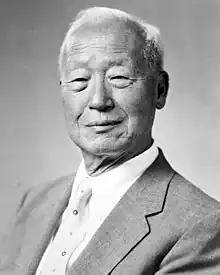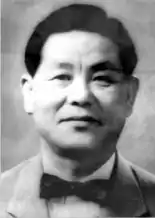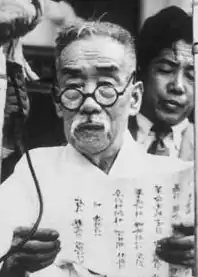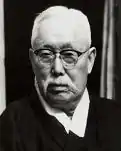| ||||||||||||||||||||||||||||||||||||||||
|
| ||||||||||||||||||||||||||||||||||||||||
Presidential election | ||||||||||||||||||||||||||||||||||||||||
| ||||||||||||||||||||||||||||||||||||||||
| ||||||||||||||||||||||||||||||||||||||||
Vice Presidential election | ||||||||||||||||||||||||||||||||||||||||
| ||||||||||||||||||||||||||||||||||||||||
| ||||||||||||||||||||||||||||||||||||||||
Presidential and vice presidential elections were held in South Korea on 5 August 1952.[1] The result was a victory for Syngman Rhee, who won 74.6% of the vote. Voter turnout was 88.1%.[2] The election was held during the Korean War, which played an important role in consolidating Rhee's support.
Background
President Rhee's factions took a devastating blow in the 1950 legislative election, when they won a little more than a quarter of the seats in the National Assembly, combined. In belief he would have little shot at reelection in the opposition-controlled legislature, President Rhee decided to amend the constitution so that the president would be elected by the people, instead of the legislature. President Rhee had the amendment pass in July 1952, after using police and military to threaten lawmakers.[3]
Results
President
| Candidate | Party | Votes | % | |
|---|---|---|---|---|
| Syngman Rhee | Liberal Party | 5,238,769 | 74.62 | |
| Cho Bong-am | Independent | 797,504 | 11.36 | |
| Yi Si-yeong | Democratic Nationalist Party | 764,715 | 10.89 | |
| Shin Heung-u | Independent | 219,696 | 3.13 | |
| Total | 7,020,684 | 100.00 | ||
| Valid votes | 7,020,684 | 96.49 | ||
| Invalid/blank votes | 255,199 | 3.51 | ||
| Total votes | 7,275,883 | 100.00 | ||
| Registered voters/turnout | 8,259,428 | 88.09 | ||
| Source: Nohlen et al. | ||||
By region
| Region | Syngman Rhee | Cho Bong-am | Yi Si-yeong | Shin Heung-u | ||||
|---|---|---|---|---|---|---|---|---|
| Votes | % | Votes | % | Votes | % | Votes | % | |
| Seoul | 205,300 | 82.2 | 25,631 | 10.3 | 14,883 | 6.0 | 3,923 | 1.6 |
| Gyeonggi | 657,174 | 87.7 | 44,967 | 6.0 | 34,704 | 4.6 | 12,891 | 1.7 |
| Gangwon | 366,583 | 92.4 | 10,516 | 2.7 | 13,378 | 3.4 | 6,305 | 1.6 |
| North Chungcheong | 386,665 | 86.7 | 25,875 | 5.8 | 23,006 | 5.2 | 10,409 | 2.3 |
| South Chungcheong | 636,061 | 82.4 | 56,590 | 7.3 | 58,754 | 7.6 | 20,947 | 2.7 |
| North Jeolla | 468,220 | 65.9 | 109,490 | 15.4 | 96,271 | 13.6 | 36,221 | 5.1 |
| South Jeolla | 823,587 | 73.6 | 99,885 | 8.9 | 165,245 | 14.8 | 30,677 | 2.7 |
| North Gyeongsang | 921,988 | 75.0 | 129,791 | 10.6 | 140,271 | 11.4 | 37,100 | 3.0 |
| South Gyeongsang | 693,523 | 55.4 | 288,654 | 23.0 | 211,544 | 16.9 | 58,586 | 4.7 |
| Jeju | 79,668 | 83.8 | 6,105 | 6.4 | 6,659 | 7.0 | 2,637 | 2.8 |
| Total | 5,238,769 | 74.6 | 797,504 | 11.4 | 764,715 | 10.9 | 219,696 | 3.1 |
| Source: National Election Commission[4] | ||||||||
Vice President
| Candidate | Party | Votes | % | |
|---|---|---|---|---|
| Ham Tae-young | Independent | 2,943,813 | 41.27 | |
| Lee Beom-seok | Liberal Party | 1,815,692 | 25.45 | |
| Chough Pyung-ok | Democratic Nationalist Party | 575,260 | 8.06 | |
| Lee Gap-sung | Liberal Party Movement | 500,972 | 7.02 | |
| Yi Yun-yong | Choseon Democratic Party | 458,583 | 6.43 | |
| Jeon Jin-han | General Alliance of Laborers for Korean Independence | 302,471 | 4.24 | |
| Louise Yim | Liberal Party Movement | 190,211 | 2.67 | |
| Pak Sung-wook | Independent | 181,388 | 2.54 | |
| Jeong Ki-won | Liberal Party Movement | 164,907 | 2.31 | |
| Total | 7,133,297 | 100.00 | ||
| Valid votes | 7,133,297 | 98.11 | ||
| Invalid/blank votes | 137,585 | 1.89 | ||
| Total votes | 7,270,882 | 100.00 | ||
| Registered voters/turnout | 8,259,428 | 88.03 | ||
By region
| Region | Ham Tae-young | Lee Beom-seok | Chough Pyung-ok | Lee Gap-sung | Yi Yun-yong | Jeon Jin-han | Louise Yim | Pak Sung-wook | Jeong Ki-won | |||||||||
|---|---|---|---|---|---|---|---|---|---|---|---|---|---|---|---|---|---|---|
| Votes | % | Votes | % | Votes | % | Votes | % | Votes | % | Votes | % | Votes | % | Votes | % | Votes | % | |
| Seoul | 70,206 | 27.6 | 117,326 | 46.2 | 16,429 | 6.5 | 13,815 | 5.4 | 15,475 | 6.1 | 8,911 | 3.5 | 4,676 | 1.8 | 4,508 | 1.8 | 2,727 | 1.1 |
| Gyeonggi | 347,799 | 45.6 | 252,090 | 33.1 | 27,776 | 3.6 | 35,154 | 4.6 | 42,038 | 5.5 | 21,076 | 2.8 | 13,195 | 1.7 | 10,547 | 1.4 | 12,593 | 1.7 |
| Gangwon | 223,534 | 55.6 | 129,704 | 32.3 | 5,962 | 1.5 | 9,427 | 2.3 | 11,555 | 2.9 | 10,675 | 2.7 | 4,424 | 1.1 | 2,811 | 0.7 | 3,674 | 0.9 |
| North Chungcheong | 216,223 | 47.8 | 130,843 | 28.9 | 18,926 | 4.2 | 23,190 | 5.1 | 24,442 | 5.4 | 13,098 | 2.9 | 9,094 | 2.0 | 7,983 | 1.8 | 8,830 | 2.0 |
| South Chungcheong | 118,291 | 15.1 | 452,209 | 57.6 | 47,482 | 6.1 | 34,172 | 4.4 | 43,895 | 5.6 | 35,057 | 4.5 | 21,047 | 2.7 | 18,354 | 2.3 | 14,287 | 1.8 |
| North Jeolla | 190,246 | 26.3 | 235,637 | 32.5 | 67,731 | 9.4 | 48,554 | 6.7 | 63,729 | 8.8 | 34,750 | 4.8 | 37,024 | 5.1 | 24,985 | 3.5 | 21,500 | 3.0 |
| South Jeolla | 729,541 | 64.2 | 59,318 | 5.2 | 125,525 | 11.0 | 77,231 | 6.8 | 60,658 | 5.3 | 23,221 | 2.0 | 20,470 | 1.8 | 18,031 | 1.6 | 22,739 | 2.0 |
| North Gyeongsang | 716,794 | 57.4 | 97,256 | 7.8 | 100,498 | 8.1 | 115,755 | 9.3 | 73,684 | 5.9 | 50,884 | 4.1 | 28,263 | 2.3 | 32,719 | 2.6 | 31,980 | 2.6 |
| South Gyeongsang | 296,766 | 23.3 | 306,982 | 24.1 | 161,787 | 12.7 | 139,000 | 10.9 | 116,260 | 9.1 | 100,061 | 7.9 | 49,675 | 3.9 | 59,079 | 4.6 | 43,807 | 3.4 |
| Jeju | 34,413 | 36.0 | 34,327 | 35.9 | 3,144 | 3.3 | 4,674 | 4.9 | 6,847 | 7.2 | 4,738 | 5.0 | 2,343 | 2.5 | 2,371 | 2.5 | 2,770 | 2.9 |
| Total | 2,943,813 | 41.3 | 1,815,692 | 25.5 | 575,260 | 8.1 | 500,972 | 7.0 | 458,583 | 6.4 | 302,471 | 4.2 | 190,211 | 2.7 | 181,388 | 2.5 | 164,907 | 2.3 |
References
- ↑ Dieter Nohlen, Florian Grotz & Christof Hartmann (2001) Elections in Asia: A data handbook, Volume II, p420 ISBN 0-19-924959-8
- ↑ Nohlen et al., p464
- ↑ "발췌개헌(拔萃改憲) - 한국민족문화대백과사전". encykorea.aks.ac.kr. Retrieved 2019-03-29.
- ↑ "개표현황". National Election Commission. Archived from the original on 2017-07-10. Retrieved 14 April 2021.





